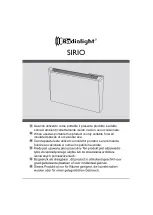
Page 21
ENGLISH
Zodiac
®
JXi
™
Gas-Fired Pool & Spa Heater
|
Installation & Operation Manual
•
Check the adjustment by turning the filter pump OFF.
The burner should shut off immediately.
•
If it does not, restart the filter pump and repeat the
preceding step.
• Check the adjustment again. If you are still unable to
successfully set your water pressure switch please
contact your local Zodiac distributor or call technical
support at 1300 763 021. Additional information can
be found at www.zodiac.com.au.
•
Return the pool temperature control to the desired
temperature.
•
Return heater to normal operation.
5.4
Check Valve Installation
When any equipment is located below the surface of the
pool or spa, back-siphoning can occur, which can draw
water backwards through the circulation system. This can
be particularly concerning if chemically treated water is
allowed to flow back into equipment such as heaters,
filters and pumps. Make sure any chemical feeder or
chlorination system outlet lines are downstream of the
heater. Install a positive seal noncorrosive check valve
between the sanitation equipment and the heater. Always
install a check valve if there is sanitation equipment
installed in the system.
Do not
install any shutoff valve in
the piping between the heater outlet and the pool.
WARNING
A check valve can interfere with the proper operation of certain Suc-
tion Vacuum Release System (SVRS) products. To avoid possible
entrapment hazard, serious injury, or death, make sure to review the
operation/owners manual of your particular SVRS product before
installing the check valve.
5.5
Pressure Relief Valve Installation
A pressure relief valve (PRV) is recommended
in all installations, and is mandatory in any
installation in which the water flow can be shut
off between the heater outlet and the pool/spa.
A pressure relief valve is not supplied with the JXi
heater. However, it is recommended that a pressure
relief valve be installed and may be required by
local or national codes. Be sure to check any
applicable installation codes in your area to determine
whether a pressure relief valve is required. If one is
required, it must meet the requirements below and
must be provided and installed by the installer
The maximum working pressure of this heater is 345 kPa
(50 psi). Be sure to take into consideration the maximum
allowable pressure of the other components in the
system when installing a PRV. Any pressure relief valve
installed must comply with provisions of the standard
INLET
TEE
REDUCER
PRV
DRAIN
OUTLET
Figure 11. Pressure Relief Valve install
•
The PRV must be compliant to AS1357.1 or ASME
certified.
•
Relief pressure must be at 3.45 bars (50 PSI)
•
Minimum rating of 7.77 Kilowatts or 125.8 kg/hr
steam rating.
•
Locate the water outlet port on the inlet/outlet header
side of the heater. This is the bottom port which
returns water to the pool and/or spa. See
Figure 11.
NOTE:
PVC and or brass fittings must be installed immediately
after the outlet with no valves or other components in between.
The pressure relief valve must be installed at the outlet port. Do not
install at the header inlet port.
CAUTION
In order to prevent damage, do not tighten with a wrench. Hand
tighten only and use caution not to overtighten. Overtightening may
crack the header.
Use Teflon
®
tape
only
on threads mating brass components to the
plastic reducer fitting. Do not use any pipe compound or pipe dope
on the threads or any part(s) that come(s) into contact with plastic.
These compounds can damage plastic components over time.
•
Using PVC or CPVC plastic pipe and fittings, install
a 50 mm (2") tee. See
Figure 11.
•
Install an elbow and a reducer fitting. Make sure the
internal pipe thread on the reducer fitting matches the
thread on the pressure relief valve.
•
Install the PRV so that it is vertical. See
Figure 11.
• Install a drain pipe from the pressure relief valve
outlet to a safe area. This is a precaution to prevent
the possibility of personal injury or property damage
in the event scalding water is discharged from the
pressure relief valve.
• Install the drain pipe so that there is no trapped or
standing water in the piping. Drain piping must be
open with no reducers or shut-off valves or other
restrictions.
NOTE:
To ensure the continued proper operation of the pressure
relief valve, the valve should be tested once a year. To test, lift the
lever with the circulation system running to ensure that water will
pass through. When the lever is down, there should be no leaks
from the outlet.
















































